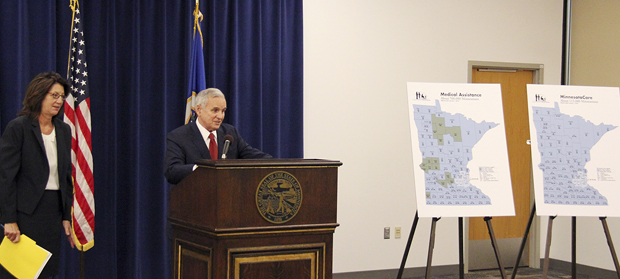ST. PAUL, MN - Governor Mark Dayton and Department of Human Services (DHS) Commissioner Lucinda Jesson today announced that Minnesota's first statewide competitive bidding process for managed care contracts, and other contract adjustments, saved taxpayers nearly $650 million. The savings come from both contracting reform (nearly $450 million) and a contract settle-up provision allowing DHS to recoup unspent health insurance dollars ($200 million). These public programs provide more than 800,000 Minnesotans high-quality health coverage. With today's savings, the Dayton Administration has implemented cost saving reforms that have resulted in more than $1.65 billion in savings for taxpayers since 2011.
"Commissioner Jesson deserves tremendous credit for her outstanding leadership in securing competitive contracts that provide better health care for Minnesotans, while saving taxpayers money said Governor Mark Dayton.
The Dayton Administration launched the state's first ever competitive bidding process for managed care contracts in 2011, which, along with other managed care reforms, saved taxpayers more than $1 billion dollars. That first competitive bidding process included only the seven county metro. In 2014, the state competitively bid an additional 27 counties. In 2015, all 87 counties were competitively bid.
In 2011, five managed care organizations (MCOs) were awarded competitive contracts worth $4 billion to cover enrollees in the state's Medical Assistance (MA) and MinnesotaCare programs. Today, DHS is expanding these competitive contracts to continue to deliver higher quality health care at about 15% lower cost compared to 2015. The contracts will be awarded after a competitive bidding process that evaluated proposals on cost, quality of care, innovation in care delivery, and other technical components.
"The competitive bidding process is about getting the best value for taxpayers and our enrollees, and that is exactly what this procurement accomplished," said Commissioner Lucinda Jesson. "In addition to hundreds of millions in taxpayer savings our enrollees will have more choice as well as high performing plans from which to choose."
Competitive bidding provides incentives for MCOs to innovate and produce the lowest cost, highest quality proposals. Each MCO went through a rigorous bidding process that evaluated proposals based on network adequacy, quality measures, technical scores, and operations capabilities. Past experience has shown that MCOs with unsuccessful bids one year may return to the process with a more competitive proposal in the next round of competitive bidding.
Contracts will be awarded on a county-by-county basis, with generally two plans options for enrollees in every Minnesota county, and three plans in each county within the 7-county metro area. In most counties Medical Assistance and MinnesotaCare enrollees will have the opportunity to choose from the same set of plans. This statewide procurement will provide greater choice to enrollees by offering more plans to choose from in 23 counties. The new contracts will take effect on January 1st 2016. The winning MCOs and the number of counties awarded for each program are:
|
|
Medical Assistance
|
MinnesotaCare
|
|
Blue Plus
|
73
|
77
|
|
HealthPartners
|
33
|
33
|
|
Medica
|
45
|
55
|
|
PrimeWest
|
13
|
13
|
|
Itasca Medical Care
|
1
|
1
|
|
South Country Health Alliance
|
1
|
1
|
|
Hennepin Health
|
1
|
1
|
At the end of 2013, DHS and the MCOs agreed to contracts based on the projected health care needs of new enrollees in Medical Assistance and MinnesotaCare in 2014. The contract change, called an "acuity adjustment" accounted for the uncertainty in patient health costs, movement between programs, and increased enrollment in coverage driven by the Affordable Care Act. This one-time, year-end "acuity adjustment" was built into the contract to ensure payments align with the actual illness level of enrollees post-Affordable Care Act. Final data on the health status of new enrollees showed that Medical Assistance and MinnesotaCare enrollees were much healthier than anticipated. As a result, the final rates have been reduced by roughly $200 million and these savings will be split between the state and federal government.
Attachments:
- /governor/assets/2015_07_28_procurement_maps_tcm1055-100656.pdfMAPS: These maps show statewide procurement of managed care organizations for Medical Assistance and MinnesotaCare in 2016.
